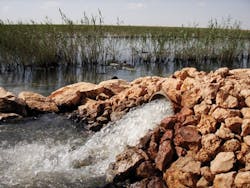Flexible Pipe Delivers Water to Cooling Station, Despite Jagged Terrain
BY JOANNA CLIMER
The terrain surrounding Delta, PA, in the Lower Susquehanna River Sub-basin is characterized by many elevation changes, which is problematic for pipe installation. The Susquehanna River Basin Commission (SRBC) notes that the northern part of the sub-basin contains ridges bearing southwest to northeast and moderately wide valleys. The river cuts through the ridges and widens as it flows south to southeast through hills and broad valleys in the central area of the sub-basin. The southern part of the sub-basin contains sediments that have been deeply folded. These sediments caused the river to carve a deep gorge into the bedrock within the narrowing river valley.
The HDPE pipe is fused together using a McElroy fusion machine inside the open trench.
The steep river slope and narrow valley of the Lower Susquehanna gorge also provide areas for hydropower, making it a major production area for electricity. However, due to the complex terrain, Conectiv Energy, the competitive wholesale subsidiary of Pepco Holdings Inc., needed a flexible, durable and environmentally sustainable pipeline in order to bring water from the Susquehanna River to a cooling tower generation station for the company’s new power plant.
The construction of the plant began in the summer of 2008, with the cooling tower pipeline as one element of the construction project. The overall project is planned to be complete by the end of the second quarter of 2011. For the cooling tower, the plant needed 22,000 feet of pipe installed to convey water from the Susquehanna River to the tower.
The new plant is located approximately 50 miles southeast of Harrisburg in Peach Bottom Township near Delta, PA. The goal of the power plant project is to provide power for the PJM power grid using state of the art, environmentally friendly technology. The plant ultimately will produce 550 megawatts (MW) of energy.
Conectiv Energy chose FM Sylvan Inc., an industrial services company, as the contractor for the project. ISCO Industries, a customized piping solutions provider, supplied the 22,000 feet of pipe needed to construct the pipeline. The pipe included 16-inch and 30-inch SDR9 PE4710 high-density polyethylene pipe (HDPE).
To join the pipe, ISCO supplied several McElroy fusion units and a Cool Pack to speed up the fusion process. When HDPE pipe is fused together, the joints become as strong as or stronger than the pipe itself. The newly fused pipe has a zero leak rate and is also weather, impact and freeze resistant. The Cool Pack speeds up fusion by shortening the time it takes for a fusion to cool, saving time during installation.
One of the reasons Conectiv Energy chose HDPE pipe for this project was due to the flexibility of the material. The pipe’s flexibility allows it to bend, flex, turn and absorb impact loads over a wide range of conditions. On this project, pipe was able to flex and bend with the elevation changes without compromising its strength or durability.
HDPE pipe is also non-toxic, hydraulically smooth and chemical and corrosion resistant, making it an ideal choice for industrial and water applications.
The pipe was installed by FM Sylvan using an open trench method. The trench only allowed for a 50 foot passage, 25 feet on each side of the pipe. Despite the small working area, the pipe and the fusion equipment were lowered into the ditch without any issue and the pipe was fused inside the trench. Most of the welds took place in-ditch, which also sped up the installation.
Overall, the pipe’s flexibility made the installation a success and water is now being piped to the cooling tower. The newly installed HDPE pipe was not compromised by the elevation changes characteristic of the river sub-basin terrain. Also, fusing the pipe inside the trench helped the installation move quickly.
The completed plant will use combined-cycle power generators to produce electricity. The plant’s fuel-efficient system consumes 20-30 percent less fuel than traditional fossil-fired boiler/steam turbine generator plants, and emits almost non-detectable levels of volatile organic emissions and carbon monoxide.
About the Author: Joanna Climer is a public relations specialist for ISCO Industries. The Louisville, KY-based ISCO Industries is a customized piping solutions provider.

